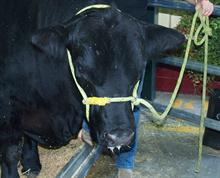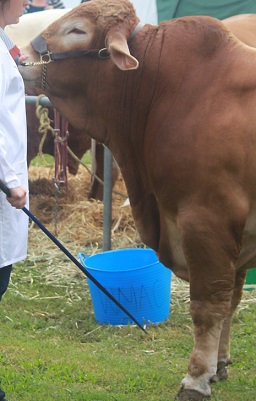Learn Beef cattle Management and Production
Beef cattle convert grass and roughage — which can't be eaten by humans — into high quality human food. In this course, you'll develop the knowledge and skills needed to analyse and make decisions about the management requirements of beef cattle.The course is designed for experiential learners and has a strong practical focus.

Course Duration: 100 hours
Course Structure
This course is ten lessons.
- Introduction to Beef Production and Beef Cattle Breeds
- The role of beef cattle in agriculture
- Scientific classification
- Examples of breeds worldwide
- British Beef breeds - Angus, Hereford, South Devon, Sussex, Red Poll
- U.S. Developed Beef breeds - Santa Gertrudis, American Brahman, Amerifax, Beefmaster
- European Beef breeds - Salers, Charolais, Simmental, Gelbvieh
- Australian Beef breeds - Braford, Beefmaster, Droughtmaster, Murray Grey, Australian Lowline
- South African Beef Breeds - Salorn, Tswana, Tuli, Afrikander
- Breed selection considerations - horned vs poll, colour, gestation length, birth weight, mothering ability, post weaning growth, meat quality, and more
- Beef Cattle Production Systems
- Various systems of production - extensive, intensive, semi-intensive
- Choosing a suitable system - considerations include size, climate, soils, transport, markets, and more
- Cattle handling facilities
- Materials used in cattle handling
- Cattle identification - branding, ear marking, tattooing, ear tags
- De-horning - chemical and mechanical
- Castration, dips and dipping, and injecting cattle
- Beef Cattle Breeding
- Heritability, performance testing, progeny testing, selection
- Pure versus cross breeding - advantages and disadvantages
- Calving percentage
- Management factors to improve calving percentage
- Weaning Calves
- Factors affecting calf weaning
- The anatomy of the male reproductive system
- The physiology of the male reproductive system
- Fertility problems in the male
- The anatomy and physiology of the female reproductive system
- Fertility problems
- Pregnancy and parturition
- The structure of the mammary glands
- Secretion of milk
- Growth and development
- Post-natal growth
- Compensatory growth
- Diseases in Beef Cattle (Viral and Bacterial)
- Determining health status of the animal
- Signs of a healthy animal
- Causes of ill-health
- Injury, poor nutrition, poisoning, parasites, hereditary conditions, and more
- Preventing ill-health
- Correct feed and nutrition, insect control, parasite control, vaccinations, control stress, and more
- Diseases in Beef Cattle (Parasites, etc.)
- Some parasitic diseases
- Other cattle ailments: actinobacillosis, anaplasmosis, arthritis, beef measles
- Poisoning, Pink eye, Milk fever, bloat, and more
- Nutrition for Beef Cattle
- Feed types: roughage and concentrates
- Carbohydrates, protein, fats; Grass or grain feeding
- Rations for beef cattle: maintenance or production rations
- Maintenance rations
- Procedure for calculating a ration
- Supplementary feeding of protein
- Lot Feeding
- Minerals
- Common macro-mineral deficiencies
- Common trace mineral deficiencies
- Diagnosis of trace mineral deficiencies
- Vitamins
- Water for farm animals
- Protein
- Commercial Herd Management
- The breeding herd
- Production systems
- Cow-calf herd
- Beef production systems using dairy stock
- Feed Lot Management
- Lot feeding: types of feedlot
- Managing cattle in a feedlot; Feedlot Records; Article on pen feeding in South Africa
- Stud Herd Management
- Time of calving
- Feeding
- Fertility
- Indicators of fertility in bulls
- Indicators of fertility in cows
- Management, Economics and Marketing
- Productivity
- Factors affecting gross output
- Factors affecting variable costs
Enrol Today
Ready to get started? Click on the orange enrol now button.
Have questions? Click here to email our course counsellors.
How Do You Decide Breeds to Raise?
%20406d.jpg)
Horned Vs Polled
Cattle with horns are more difficult to handle. This can result in bruising of meat, an important issue in marketing beef. Dehorning requires extra work for the producer and there is also the danger of infection or insect injury (especially in countries where screw worms is a problem).
Colour
Colour in some climates, can affect productivity of beef. In hot climates with intense sunlight, a light coat colours absorb less heat from the sun and aids in maintaining body temperature. In cold climates white udders may result in “snow burn”. Pigment around the eyes in white-faced cattle reduces the incidence of cancer of the eyelid. A uniform colour provides the appearance (or illusion) of uniformity of type or conformation in a group of cattle.
Also a distinctive colour or colour pattern forms the trademark of particular breeds and for this reason breed societies adopt standard colours or colour patterns. The issue of selective breeding based on coat colour alone may result in the culling of animals regardless of their other merits, especially in breeds where uniform coat colour has proven difficult to “fix”. To the extent that selection is made for coat colour, selection pressure for traits of greater economic importance is reduced.
Gestation Length and Birth Weight
Observable differences appear to exist between breeds, for example, some studies have found that in purebred Angus cattle, the gestation length averages 3 to 8 days less than Hereford or Shorthorn and calves are on average 5 to 8 pounds lighter at birth. Purebred Brahman cattle on average have gestation periods that are a few days longer than the British breeds. Crossing Brahman bulls with British cows tends to result in longer gestations.
Milking and Mothering Ability
The weaning weight of calves is a very important factor in profitable beef production. Some studies have shown that Angus cows tend to wean heavier calves than Herefords. In some areas Brahman cattle or Brahman cross cattle tend to wean calves that are considerably heavier than British breeds. Mothering ability is an important characteristic that varies within breeds and needs to be considered in any selection program.
Post Weaning Growth
The ability to gain weight rapidly and efficiently after weaning is another important consideration. Environmental and genetic factors will affect post weaning growth rates.
Meat Quality
Meat quality refers to the palatability of meat, including tenderness, juiciness and flavour. Beef carcass quality grades are generally based on visual appraisal of the physiological maturity of the carcass and the intramuscular fat (marbling). Marbling can be influenced by selective breeding. Studies have found that cattle breeds such as Angus, Murray Grey, Shorthorns, and Wagyu cattle have higher marbling scores (on average) compared to cattle such as Simmentals, Charolais and Chianina. Marbling can also be influenced by time on feed and the type of feed.
Stress can affect meat colour and toughness. Dark-cutting beef (DCB) commonly results when cattle are subjected to prolonged stress just prior to slaughter. Muscle glycogen, or the energy reserves of the animal, has a large influence on meat colour and pH. Good quality beef has a final pH value close to 5.5. The disposition of cattle is very important as calm-natured cattle will produce less “dark-cutting” meat.
The following factors may also contribute to dark cutting beef (DCB):
- low energy intake by livestock
- poor livestock handling
- mixing groups of animals
- severe weather conditions during transport
Suitability of purpose

The choice of cattle breed is largely determined by the individual situation and markets. For example, many lot feeders show a preference for Angus cattle particularly if feeding for the Asian market. Intensive growing and range grazing situations might require different breeds. The climatic situation also has a large bearing on breed suitability. Brahman cattle, for example, are adapted to handle tropical situations. They appear to handle poorer quality pastures better and have a high degree of tolerance to many external parasites when compared with British breeds.
Heat Adaptation
British bred cattle were developed in areas of temperate climate and generally don’t have thermo-regulatory mechanisms good enough to maintain body temperatures in a hot environment.
Hereditary defects
Hereditary defects occur in many cattle breeds and producers should be aware of these. For example, dwarfism has been a problem in Herefords and Angus cattle. Culling of breeding animals who exhibit undesirable traits will be necessary.